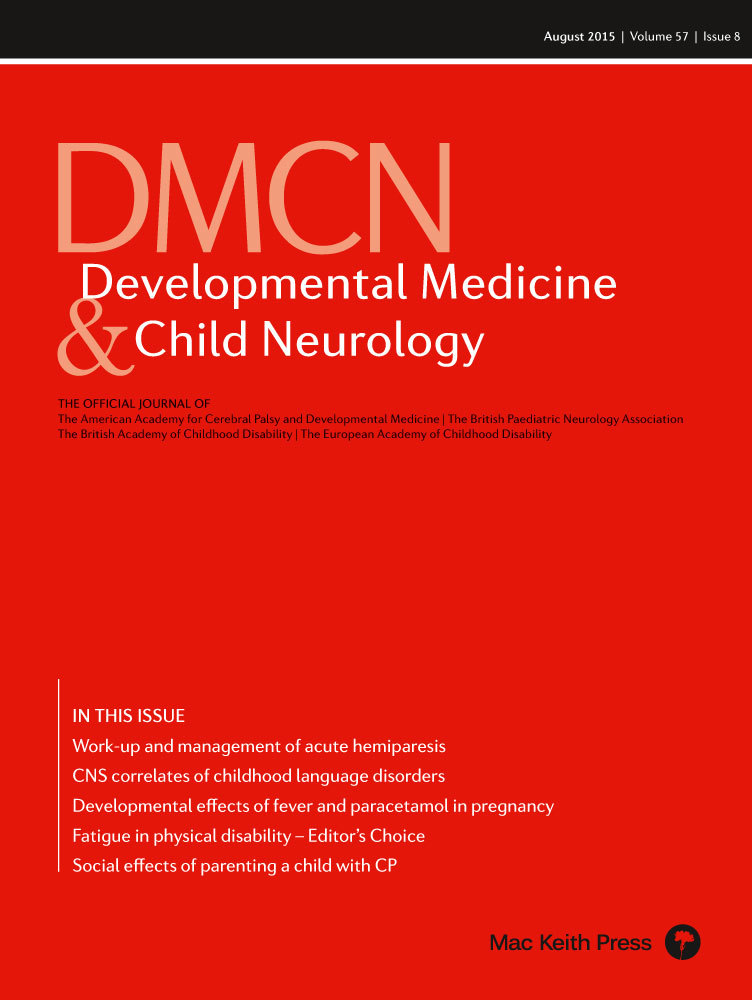Movement towards enhancing self-management and exercise prescription through use of the OMNI Walk/Run Rating of Perceived Exertion scale
Abstract
This commentary is on the original article by Fragala-Pinkham et al. on pages 748–753 of this issue.
Several studies have demonstrated that children and young people are not meeting the recommended daily or weekly physical activity guidelines in order to achieve the appropriate health benefits of being active. This is true not only of children and adolescents who are developing typically; but, and perhaps more importantly, it is also true for individuals with developmental disabilities such as cerebral palsy (CP).1 In addition, clinicians have long recognized the importance of physical activity for individuals with CP; yet increasing participation in such activities has been a difficult task, in part due to the development of secondary musculoskeletal conditions such as increased fatigue and pain that may be related to being active.2 In a recent qualitative study, individuals with CP described difficulty with predicting and managing fatigue from activities of daily living such as walking.3 When this is combined with other literature that demonstrates individuals with CP experience more fatigue than the general population,4 the question that arises is: ‘Do we know how active these individuals need to be in order to gain appropriate health benefits while mitigating the negative consequences of pain and fatigue?’ This question remains unanswered, partially due to the fact that most activities of daily living for these individuals result in increased energy expenditure and effort. As researchers and clinicians we have failed to appropriately measure and understand the impact this increased energy cost may have on the motivation to be active and the practical aspects of participating in 60 minutes of moderate-to-vigorous physical activity daily.
Fragala-Pinkham et al.5 have helped move this research question forward in their paper describing the validation of the OMNI Walk/Run Rating of Perceived Exertion (OMNI-RPE) scale for ambulatory children and adolescents with CP. In this study the authors recognize the importance of measuring perceived exertion for individuals with CP in a practical manner.5 The traditional methods of gathering information about exercise intensity from objective laboratory measures such as oxygen consumption, heart rate monitors, or accelerometry are useful for academic research and to clinicians prescribing exercise programs; however, there are concerns with cost and participation burden and impact of testing for the individuals providing the data. Instead, a simple perceived exertion measure allows for individuals with CP to self-administer this measure beyond the initial exercise prescription meeting and use it as a management tool throughout the activities that generate fatigue. Fragala-Pinkham et al. demonstrated a keen understanding of the need for a valid, practical, and applicable measure for individuals with CP, their clinicians, and the scientific community that reflects real-life activities. The authors undertook the task validating the OMNI-RPE and perceived exertion associated with ordinary day-to-day tasks as these are often the fatigue-generating activities for individuals with CP. The authors were able to demonstrate that OMNI-RPE scores were highly correlated to heart rate and oxygen consumption scores for ambulatory participants with CP. This suggests that the exercise intensity in real-life activities performed during the day such as writing, household chores, and walking could be accurately monitored in ambulatory children and adolescents with CP through the use of a simple, easily administered, and interpreted rating of perceived exertion.5
A validated measure such as the OMNI-RPE has the potential to increase the ability of individuals with CP to self-manage their fatigue and physical activity levels to increase their overall health and well-being. Further research is needed to determine if the OMNI-RPE could be used to prescribe exercise intensity for ambulatory adolescents with CP; however, the OMNI-RPE is both practical and economical and offers clinicians an additional tool to consider when prescribing exercise and self-management programs for children and young people with CP. Self-management of secondary musculoskeletal conditions is paramount to influencing quality of life and health for individuals with CP. Fragala-Pinkham et al. have provided evidence of a validated tool that promises to have great impact on both clinical practice and the academic literature.




